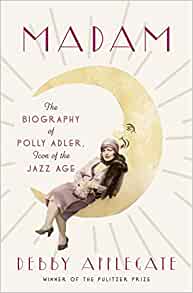Books |
Madam: The Biography of Polly Adler, Icon of the Jazz Age
Debby Applegate
By
Published: Nov 01, 2021
Category:
Biography
When I met Debby Applegate, who had graduated summa cum laude from Amherst and collected a Ph.D. in American Studies at Yale, it was clear she was super smart. Not that her intelligence was much consolation. Like me, she seemed to be struggling with a book. Unlike me, she struggled with her first book for 20 years. Then, in 2007, that book — The Most Famous Man in America: The Biography of Henry Ward Beecher — won the Pulitzer Prize for biography.
What to do next? Something different. Applegate happened upon “A House Is Not a Home,” the not-quite-tell-all memoir of Polly Adler, a madam always described as “notorious.” And thus began a decade of research. “The Most Famous Man in America” filled 560 pages. “Madam: The Biography of Polly Adler, Icon of the Jazz Age,” runs to 576 pages, but because there’s still a bit of the graduate student in Applegate, that mercifully includes 33 pages of footnotes and a 12-page bibliography.
I’m an evangelist for short books, but I stayed up night after night with “Madam” because it’s so much more than the story of a woman who serviced the sexual desires of white men — it’s a cultural and political history of New York in the 1920s and 1930s. Adler was 5’ in high heels, weighed 116 pounds, wasn’t beautiful, sounded as if she’d never left Brooklyn. As she said, “I had to become a madam, I was never pretty enough to be a hustler.” What she did have were stellar virtues. When arrested, she never made her situation easier by implicating others. She had a sunny personality and a quick wit. And she was a hard worker: “I took care of my phone 24 hours a day and never said no to anyone who was out to spend.” In her way, she was honorable: “You left with your wallet and reputation intact.”
Because she was “someone a villain could trust,” her apartments became a favorite destination of gangsters like Arnold Rothstein, “a keen believer in the power of a skirt,” Lucky Luciano, and Frank Costello. The literati were sex-obsessed, and she soon acquired the friendship of the Algonquin Round Table. Walter Winchell, a friend, called her the “Queen of Hookaville.” She knew the Marx Brothers, “all of them leches.” Dorothy Malone apprenticed with her. Joe DiMaggio complained that his knees slipped on Polly’s satin sheets; she replaced them with cotton for him.
The sex gets your attention, but the fascination of this book lies in the intersection of sex with politics and culture: “For the first time in American history, the luminaries of politics, finance, and show business were mingling as equals.” Every politician in New York City seems to have been corrupt, and it was at Polly’s that they could do dirty business without interference. This included judges. And vice cops who made occasional arrests so madams would pay off lawyers and judges.
What astonished me was the wildness. In 1920, there were 15,000 speakeasies in New York. Many buildings on Riverside Drive and West End Avenue were home to a madam or an independent prostitute. Criminals were shot everywhere. Witnesses and evidence disappeared. A group called the Committee of Fourteen pressed for indictments against male patrons of brothels. That effort got some traction until it didn’t. FDR bent some codes to win gangsters’ support. And through it all, there was a mad, manic party:
That season was a blur of red-faced sugar daddies, glassy-eyed girls, and flashing greenbacks; of smoke-filled rooms echoing with eddies of laughter, the click of dice, and the blare of saxophones; of tumbling into bed at first light and awakening to a throbbing, nerve shattering hangover at noon.
If we didn’t know this story before, Applegate writes, it’s because America has long bought the idea that male criminals are more compelling than New York’s “Empress of Vice.” There is “no myth of the female outlaw who uses sex as her weapon against the world.” And sex between strangers is an endlessly popular fantasy: “desires without limits or consequences, spontaneous ecstasy on command, and whatever else the human id can dream up and pay for.”
Applegate, in her conclusion, sees sex workers clearly, as actresses who deal in illusion. Which is why the stories in “Madam” deliver more grit, passion, longing and tragedy than the Hollywood movies we see on Turner Classics. Which is why I stayed up late every night for a week.
[To buy the book from Amazon, click here. For the Kindle edition, click here.]


